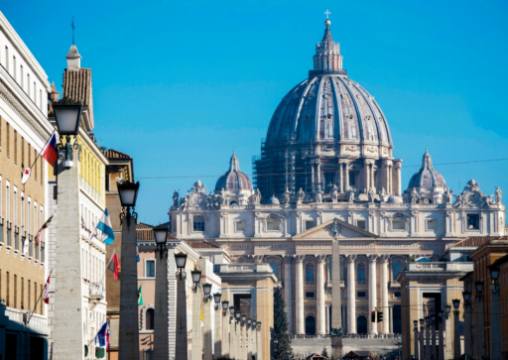In the heart of St. Peter's Basilica in Vatican City stands a magnificent bronze statue that has been a focal point of admiration and controversy for centuries. Depicting the revered figure of St. Peter, this statue holds deep significance for both religious pilgrims and art enthusiasts alike. Despite the controversies surrounding its origins and appearance, efforts have been made to preserve and restore this iconic piece of history for future generations to appreciate.

Significance of the Bronze Statue in St. Peter's Basilica
The Bronze Statue of St. Peter holds great significance in St. Peter's Basilica as it is a symbol of the Catholic Church and a tribute to one of the most important figures in Christianity. The statue serves as a reminder of the legacy and teachings of St. Peter, the first pope and a key apostle of Jesus Christ. It attracts pilgrims and tourists from all over the world who come to pay their respects and seek blessings from the patron saint of the church. The presence of the Bronze Statue also adds to the overall beauty and grandeur of St. Peter's Basilica, drawing admiration from all who visit the sacred site.
Depiction and Symbolism of St. Peter in the Statue
The bronze statue of St. Peter located in St. Peter's Basilica in Vatican City is a powerful depiction of the apostle. In the statue, St. Peter is shown sitting on a throne, holding the keys to heaven in one hand and a book representing the Gospels in the other. This imagery symbolizes St. Peter's role as the first pope and the keeper of the keys to the kingdom of heaven.
The statue also depicts St. Peter with a long beard and wearing traditional papal robes, further emphasizing his importance and authority within the Catholic Church. His facial expression is stern and serious, reflecting the gravitas of his position as the leader of the church.
The symbolism of the keys held by St. Peter in the statue is particularly significant, as they represent the authority given to him by Jesus Christ in the Gospel of Matthew. According to Catholic tradition, St. Peter was chosen by Christ to be the head of the church, with the power to bind and loose sins on earth. The keys symbolize this authority to grant access to heaven to believers.
Overall, the depiction of St. Peter in the bronze statue serves to honor his role as the first pope and the foundation of the Catholic Church. The symbolism present in the statue reinforces the importance of St. Peter within the church's hierarchy and the belief in his spiritual leadership.
Controversies Surrounding the Bronze Statue
The Bronze Statue of St. Peter, housed in St. Peter's Basilica in Vatican City, has been the subject of controversies since its creation. One of the main debates surrounding the statue is the true artist behind its design and creation. While many attribute the statue to Arnolfo di Cambio, others believe it was actually sculpted by the renowned artist Michelangelo. This discrepancy has fueled heated discussions among art historians and scholars.
Another controversy surrounding the Bronze Statue of St. Peter is the actual depiction of the apostle. Some critics argue that the statue does not accurately represent St. Peter, pointing to inconsistencies in the facial features and the overall composition of the sculpture. Others have raised concerns about the historical accuracy of the statue, questioning whether it truly captures the essence of the saint it is meant to portray.
Furthermore, some individuals have questioned the religious implications of the statue, particularly regarding the practice of pilgrims touching and kissing the foot of St. Peter as a form of veneration. Critics argue that this ritual perpetuates superstition and detracts from the true significance of the statue as a work of art.
Despite these controversies, the Bronze Statue of St. Peter remains a prominent fixture in St. Peter's Basilica and continues to draw visitors from around the world. Efforts have been made to address some of the concerns raised by critics, including initiatives to provide more information about the statue's history and provenance. Ultimately, the controversies surrounding the statue serve to underscore its enduring impact and significance in the world of art and religion.
Restoration and Preservation Efforts for the Bronze Statue
Peter in St. Peter's Basilica has undergone various restoration and preservation efforts over the years to ensure its longevity and historical significance. The statue, created by Arnolfo di Cambio in the 13th century, has faced deterioration due to weather conditions, pollution, and the natural aging process.
In recent years, the Vatican has taken significant steps to preserve the Bronze Statue of St. Peter. Conservationists have utilized modern techniques and technologies to clean and protect the statue from further damage. This includes carefully removing dirt and grime, repairing any cracks or damage, and applying protective coatings to prevent corrosion.
Additionally, ongoing maintenance and monitoring of the statue have been implemented to ensure its continued preservation. Regular inspections are conducted to assess the condition of the statue and address any issues that may arise. This proactive approach helps to safeguard the Bronze Statue of St. Peter for future generations to admire and appreciate.
Overall, the restoration and preservation efforts for the Bronze Statue of St. Peter in St. Peter's Basilica highlight the importance of conserving cultural and historical artifacts. By taking care of these significant pieces of art, we can ensure that they remain a cherished part of our heritage for years to come.
